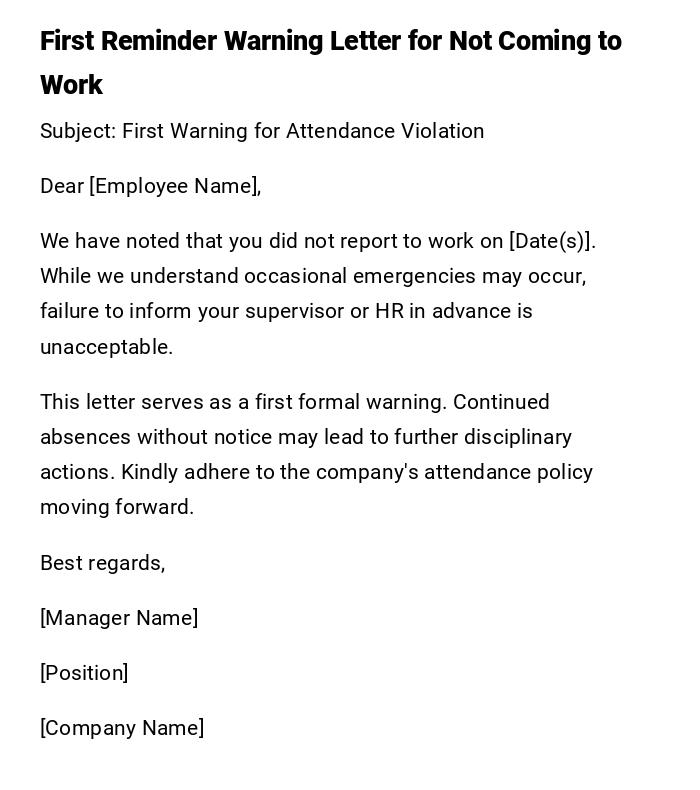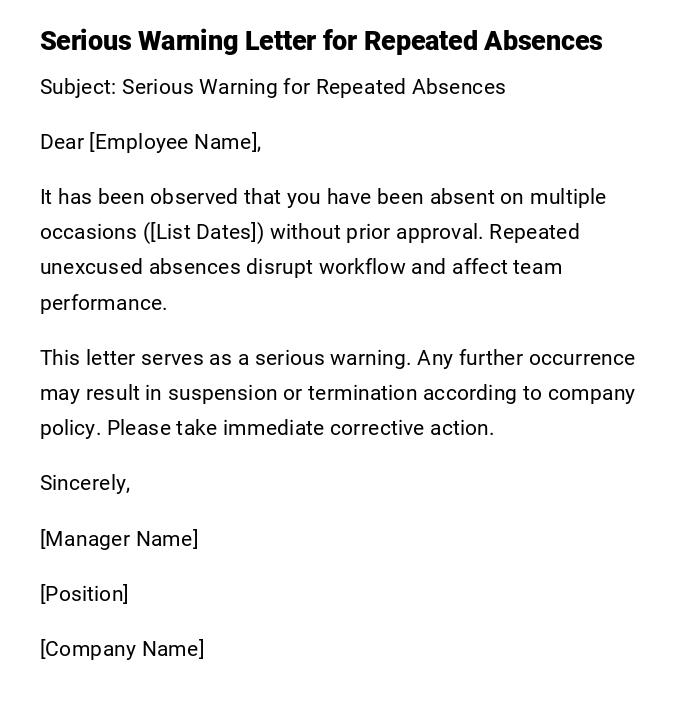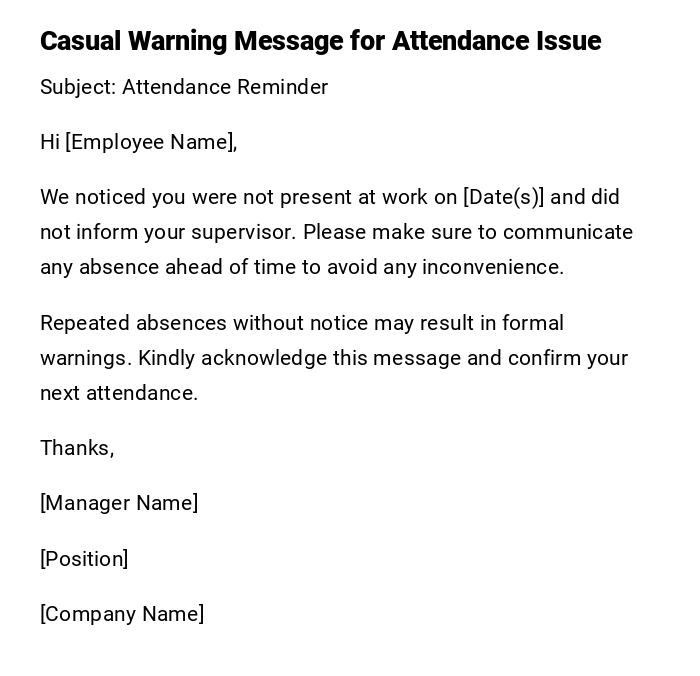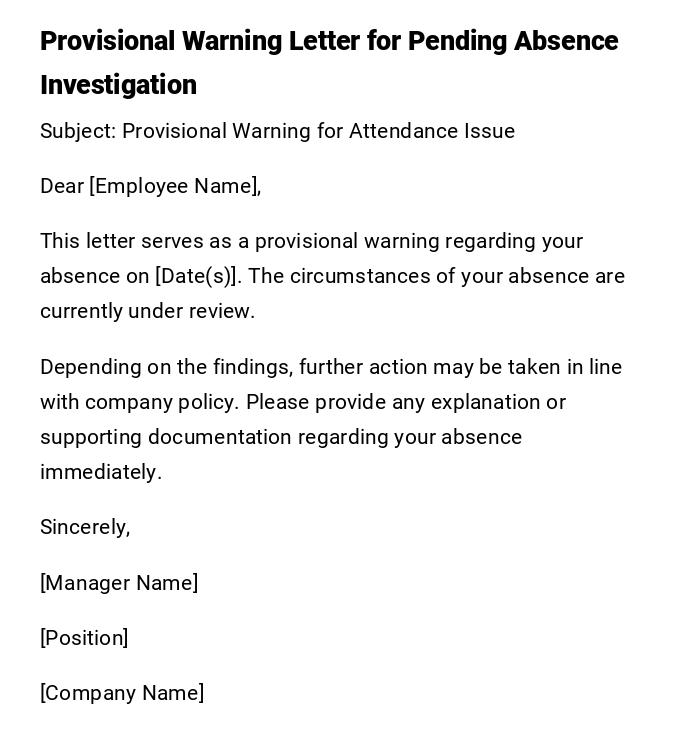Warning Letter To Employee For Not Coming To Work
[Your Name]
[Your Title/Position]
[Company Name]
[Company Address]
[City, State, Zip Code]
[Date]
[Employee's Name]
[Employee's Position]
[Employee's Department]
[Company Address]
[City, State, Zip Code]
Dear [Employee's Name],
Subject: Warning Letter for Unauthorized Absence
I am writing this letter to express my concern regarding your recent unauthorized absence from work on [Date(s) of Absence]. It has come to our attention that you did not report to work and did not seek prior approval for your absence. As an employee of [Company Name], it is essential to abide by company policies and adhere to the rules and regulations set forth in the employee handbook.
Your absence without any valid reason or prior notice creates operational difficulties and negatively impacts the productivity and functioning of the team. It is crucial for all employees to maintain regular attendance and punctuality to ensure the smooth operation of the company and to meet our business goals.
As per the company's attendance policy, any absence from work must be reported to your immediate supervisor or the HR department as soon as possible. If you are unable to attend work due to unforeseen circumstances, you are required to notify the company in advance and provide appropriate documentation supporting your absence.
Please understand that unauthorized absences are taken seriously, and it reflects negatively on your commitment to your job responsibilities and the company as a whole. Therefore, we expect you to treat this matter seriously and ensure that such incidents do not occur in the future.
Going forward, we expect the following from you:
1. Adhere strictly to the company's attendance policy, including notifying your supervisor or HR in advance for any planned absences or providing valid reasons for unplanned absences.
2. In case of any health or personal issues that may affect your attendance, notify your supervisor or the HR department as soon as possible and provide relevant documentation, if applicable.
3. Improve your punctuality and attendance to fulfill your job responsibilities effectively.
Failure to rectify your attendance and punctuality issues may result in further disciplinary action, including written warnings, suspension, or even termination of employment.
We believe in your potential as an employee, and we want to support you in being successful at your job. If you are facing any challenges that are affecting your attendance, please feel free to discuss them with your supervisor or HR, and we will explore possible solutions together.
This warning letter is being documented in your employee file, and we sincerely hope that you will take the necessary steps to address this matter promptly. We trust that you will demonstrate the professionalism and commitment expected of you as a valued member of our team.
If you have any questions or need further clarification, please do not hesitate to reach out to your supervisor or the HR department.
Sincerely,
[Your Name]
[Your Title/Position]
[Company Name]
Official Warning Letter for Unexplained Absence
Subject: Warning for Unauthorized Absence
Dear [Employee Name],
It has come to our attention that you were absent from work on [Date(s)] without prior notice or authorization. This behavior violates company policies regarding attendance and punctuality.
You are hereby warned that any further unauthorized absences may result in disciplinary action, up to and including termination of employment. Please ensure you report to work as scheduled and communicate any legitimate reasons for absence in advance.
Sincerely,
[Manager Name]
[Position]
[Company Name]
First Reminder Warning Letter for Not Coming to Work
Subject: First Warning for Attendance Violation
Dear [Employee Name],
We have noted that you did not report to work on [Date(s)]. While we understand occasional emergencies may occur, failure to inform your supervisor or HR in advance is unacceptable.
This letter serves as a first formal warning. Continued absences without notice may lead to further disciplinary actions. Kindly adhere to the company's attendance policy moving forward.
Best regards,
[Manager Name]
[Position]
[Company Name]
Serious Warning Letter for Repeated Absences
Subject: Serious Warning for Repeated Absences
Dear [Employee Name],
It has been observed that you have been absent on multiple occasions ([List Dates]) without prior approval. Repeated unexcused absences disrupt workflow and affect team performance.
This letter serves as a serious warning. Any further occurrence may result in suspension or termination according to company policy. Please take immediate corrective action.
Sincerely,
[Manager Name]
[Position]
[Company Name]
Formal Warning Email for Non-Attendance
Subject: Warning: Non-Attendance
Hello [Employee Name],
This is to inform you that your absence from work on [Date(s)] was noted without any prior notice or valid reason. Attendance is critical to our operations, and failure to comply with policies cannot be ignored.
Consider this an official warning. Further unapproved absences may lead to stricter disciplinary measures. Please ensure timely communication for any future absences.
Regards,
[Manager Name]
[Position]
[Company Name]
Casual Warning Message for Attendance Issue
Subject: Attendance Reminder
Hi [Employee Name],
We noticed you were not present at work on [Date(s)] and did not inform your supervisor. Please make sure to communicate any absence ahead of time to avoid any inconvenience.
Repeated absences without notice may result in formal warnings. Kindly acknowledge this message and confirm your next attendance.
Thanks,
[Manager Name]
[Position]
[Company Name]
Provisional Warning Letter for Pending Absence Investigation
Subject: Provisional Warning for Attendance Issue
Dear [Employee Name],
This letter serves as a provisional warning regarding your absence on [Date(s)]. The circumstances of your absence are currently under review.
Depending on the findings, further action may be taken in line with company policy. Please provide any explanation or supporting documentation regarding your absence immediately.
Sincerely,
[Manager Name]
[Position]
[Company Name]
What a Warning Letter for Not Coming to Work Is and Why It Is Important
A Warning Letter for Not Coming to Work is a formal notice given to an employee who fails to attend work without prior approval.
Purpose:
- To officially inform the employee of their violation of attendance policies.
- To provide an opportunity to correct behavior before further disciplinary actions.
- To maintain proper documentation for HR and legal purposes.
Who Should Send a Warning Letter for Employee Absence
- Direct supervisors or line managers.
- Human Resources personnel overseeing attendance and compliance.
- Department heads in cases of repeated or serious violations.
Whom the Warning Letter Should Be Addressed To
- The employee who has been absent without valid notice.
- In cases of serious infractions, copies may also be sent to HR records.
- Supervisors may also include department heads for formal documentation.
When a Warning Letter for Absence Should Be Issued
- First unexcused absence without prior notification.
- Repeated absences that violate attendance policies.
- Pending investigation of unexplained absences.
- When the absence impacts workflow or team performance.
How to Write a Warning Letter for Not Coming to Work
- Begin with a clear subject line indicating the purpose.
- Address the employee directly and respectfully.
- Mention specific dates of absence and lack of authorization.
- Refer to company policies on attendance.
- Clearly state the warning level (first, serious, final).
- Include instructions for corrective action and potential consequences.
Requirements and Prerequisites Before Sending a Warning Letter
- Verify attendance records to confirm unauthorized absence.
- Check if the employee provided any prior notice or explanation.
- Consult company attendance policies and disciplinary procedures.
- Gather dates and documentation to support the warning.
Formatting Guidelines for Warning Letters
- Length: One page is usually sufficient.
- Tone: Professional and serious; avoid overly emotional language.
- Structure: Subject, greeting, explanation of absence, reference to policy, warning, corrective instructions, signature.
- Mode: Printed letter or email depending on company protocol.
After Sending the Warning Letter / Follow-Up Actions
- Confirm the employee has received and acknowledged the letter.
- Document the warning in the HR records.
- Monitor attendance to ensure compliance.
- Schedule a meeting if necessary to discuss corrective measures.
Pros and Cons of Sending a Warning Letter for Absence
Pros:
- Provides clear communication regarding company expectations.
- Helps maintain workplace discipline.
- Creates an official record for HR and legal purposes.
Cons:
- May create tension if not handled diplomatically.
- Could demotivate employees if used excessively.
- Requires careful documentation to avoid disputes.
Tricks and Tips for Effective Warning Letters
- Be specific with dates and details of absence.
- Maintain a neutral, professional tone.
- Use company policy references to justify the warning.
- Include instructions for correction and consequences of non-compliance.
- Keep copies for HR documentation.
Common Mistakes to Avoid in Warning Letters
- Sending letters without verifying attendance records.
- Using accusatory or emotional language.
- Failing to mention consequences of continued absence.
- Not providing an opportunity for employee response or explanation.
Elements and Structure of a Warning Letter for Employee Absence
- Subject Line: Clearly indicate it's a warning.
- Greeting: Address the employee by name.
- Introduction: State reason for the warning.
- Details: List dates of absence and relevant policy violations.
- Warning Statement: Indicate seriousness and potential consequences.
- Corrective Instructions: Provide guidance on expected behavior.
- Closing: Signature and designation of the sender.
Does a Warning Letter for Not Coming to Work Require Attestation or Authorization
- Typically, the letter should be signed by the immediate supervisor or manager.
- For formal HR records, HR department or department head may co-sign.
- Authorization ensures the warning is official and enforceable.








 Download Word Doc
Download Word Doc
 Download PDF
Download PDF